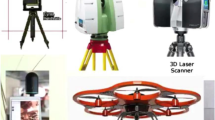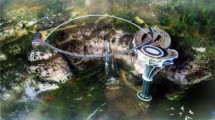Abstract
Nowadays, terrestrial laser scanning (TLS) technology is increasingly utilized in the field of bridge maintenance, because of its efficiency and speed of execution. However, challenges still remain for the practice of long-span bridges. In fact, for long-span bridges, the accuracy of point cloud data can be specially affected by the scan geometry. Long-span bridges such as suspension bridges, cable-stayed bridges or arch bridges are often used to cross rivers or valleys, which means that they are less sheltered by the natural environment, the main girders are extremely long, their length is close to the range of the scanner, and the conditions for setting up measurement stations often do not exist below the main span. This state of affairs forces us to adopt unfavorable scanning geometry, making scanning with small angles of incidence unavoidable, which may result in points cloud missing and inaccurate point cloud information for distant bridge components. To eradicate this challenge, we developed herein a portable auxiliary reflector to assist TLS scanner to obtain the intact and accurate point cloud data of a long-span bridge in unfavorable scan geometry conditions. In-filed tests have been conducted on the Ma’anshan Yangtze River Bridge with two 1080m spans for three consecutive years. We provide details about the whole scanning process, together with the identified results of bridge spatial deformation. Results show that the distant girder and cable points cloud data can be obtained entirely with high precision. Then, further comparative deformation analysis can be guaranteed based on the integrated points cloud data.















Similar content being viewed by others

Data availability
Data will be made available on request.
References
American Society of Civil Engineers (2017) Infrastructure report card. MUD history. https://www.infrastructurereportcard.org
European Commission, Joint Research Centre, Gkoumas K, Balen M, Grosso M, et al (2019) Research and innovation in bridge maintenance, inspection and monitoring – A European perspective based on the Transport Research and Innovation Monitoring and Information System (TRIMIS). Publications Office. https://doi.org/10.2760/16174
Qin X, Liao M, Yang M, Zhang L (2017) Monitoring structure health of urban bridges with advanced multi-temporal InSAR analysis. Ann GIS 23:293–302. https://doi.org/10.1080/19475683.2017.1382572
Hu J, Wang L, Song X et al (2020) Field monitoring and response characteristics of longitudinal movements of expansion joints in long-span suspension bridges. Measurement (Lond). https://doi.org/10.1016/j.measurement.2020.107933
Xi C, Zhou Z, Xiang X et al (2018) Monitoring of long-span bridge deformation based on 3D laser scanning. Instrum Mesure Métrologie 18:113–130. https://doi.org/10.3166/i2m.17.113-130
Rizzo P, Enshaeian A (2021) Challenges in bridge health monitoring: a review. Sensors 21:4336. https://doi.org/10.3390/s21134336
Yi T-H, Li H-N, Gu M (2013) Experimental assessment of high-rate GPS receivers for deformation monitoring of bridge. Measurement 46:420–432. https://doi.org/10.1016/j.measurement.2012.07.018
Kaloop MR, Hussan M, Kim D (2019) Time-series analysis of GPS measurements for long-span bridge movements using wavelet and model prediction techniques. Adv Space Res. 63:3505–3521. https://doi.org/10.1016/j.asr.2019.02.027
Moschas F, Stiros S (2011) Measurement of the dynamic displacements and of the modal frequencies of a short-span pedestrian bridge using GPS and an accelerometer. Eng Struct 33:10–17. https://doi.org/10.1016/j.engstruct.2010.09.013
Psimoulis PA, Stiros SC (2007) Measurement of deflections and of oscillation frequencies of engineering structures using Robotic Theodolites (RTS). Eng Struct 29:3312–3324. https://doi.org/10.1016/j.engstruct.2007.09.006
Zainon O, Sin FK (2021) Monitoring of concrete bridge using robotic total station. J Adv Geospat Sci Technol 1:163–192
Myers J (2004) Use of the total station for serviceability monitoring of bridges with limited access. 16th World Conference on NDT - 2004 - Montreal (Canada). https://www.ndt.net/?id=2169
Perry BJ, Guo Y, Atadero R, van de Lindt JW (2020) Streamlined bridge inspection system utilizing unmanned aerial vehicles (UAVs) and machine learning. Measurement. 164:108048. https://doi.org/10.1016/j.measurement.2020.108048
Hajializadeh D (2023) Deep learning-based indirect bridge damage identification system. Struct Health Monit 22:897–912. https://doi.org/10.1177/14759217221087147
Kaartinen E, Dunphy K, Sadhu A (2022) LiDAR-based structural health monitoring: applications in civil infrastructure systems. Sensors 22:4610. https://doi.org/10.3390/s22124610
Kuznetsova I, Kuznetsova D, Rakova X (2015) The use of surface laser scanning for creation of a three-dimensional digital model of monument. Procedia Eng 100:1625–1633. https://doi.org/10.1016/j.proeng.2015.01.536
Xu X, Yang H (2018) Network method for deformation analysis of three-dimensional point cloud with terrestrial laser scanning sensor. Int J Distrib Sens Netw 14:1550147718814139
Jia D, Zhang W, Liu Y (2021) Systematic approach for tunnel deformation monitoring with terrestrial laser scanning. Remote Sens (Basel) 13:3519. https://doi.org/10.3390/rs13173519
Macchiarulo V, Milillo P, Blenkinsopp C, Giardina G (2022) Monitoring deformations of infrastructure networks: a fully automated GIS integration and analysis of InSAR time-series. Struct Health Monit 21:1849–1878. https://doi.org/10.1177/14759217211045912
Xie X, Lu X (2017) Development of a 3D modeling algorithm for tunnel deformation monitoring based on terrestrial laser scanning. Undergr Sp 2:16–29. https://doi.org/10.1016/j.undsp.2017.02.001
Kitratporn N, Takeuchi W, Matsumoto K, Nagai K (2018) Structure deformation measurement with terrestrial laser scanner at Pathein bridge in Myanmar. J Disaster Res 13:40–49
Zhang H, Zhu Y, Xiong W, Cai CS (2023) Point cloud registration methods for long-span bridge spatial deformation monitoring using terrestrial laser scanning. Struct Control Health Monit 2023:1–16. https://doi.org/10.1155/2023/2629418
Wang W, Zhao W, Huang L et al (2014) Applications of terrestrial laser scanning for tunnels: a review. J Traffic Transp Eng (English Edition) 1:325–337
Rashidi M, Mohammadi M, Sadeghlou Kivi S et al (2020) A decade of modern bridge monitoring using terrestrial laser scanning: review and future directions. Remote Sens (Basel) 12:3796. https://doi.org/10.3390/rs12223796
Rosado L, van Pevenage J, Vandenabeele P et al (2018) Multi-analytical study of ceramic pigments application in the study of iron age decorated pottery from SW Iberia. Measurement. 118:262–274. https://doi.org/10.1016/j.measurement.2017.05.016
Stahl T, Tye A (2020) Schmidt hammer and terrestrial laser scanning (TLS) used to detect single-event displacements on the Pleasant Valley fault (Nevada, USA). Earth Surf Process Landf. 45:473–483. https://doi.org/10.1002/esp.4748
Hodgetts D (2013) Laser scanning and digital outcrop geology in the petroleum industry: a review. Mar Pet Geol 46:335–354. https://doi.org/10.1016/j.marpetgeo.2013.02.014
Fuchs PA, Washer GA, Chase SB, Moore M (2004) Applications of laser-based instrumentation for highway bridges. J Bridg Eng 9:541–549. https://doi.org/10.1061/(ASCE)1084-0702(2004)9:6(541)
Riveiro B, Morer P, Arias P, de Arteaga I (2011) Terrestrial laser scanning and limit analysis of masonry arch bridges. Constr Build Mater. 25:1726–1735. https://doi.org/10.1016/j.conbuildmat.2010.11.094
Ormeni R, Bejko E, Gjata G (2019) The use of technology opportunities with terrestrial laser scanning image for 3D bridge modelling and monitoring. J Int Environ Appl Sci 14:122–131
Lõhmus H, Ellmann A, Märdla S, Idnurm S (2018) Terrestrial laser scanning for the monitoring of bridge load tests—two case studies. Surv Rev 50:270–284. https://doi.org/10.1080/00396265.2016.1266117
Deng Y, Jia Y, Li Y, Li A (2022) Structural parameter identification of ancient stone arch bridge via three-dimensional laser ranger scanning. J Perform Constr Facilities. https://doi.org/10.1061/(ASCE)CF.1943-5509.0001752
Riveiro B, González H, Varela M, Jauregui DV (2013) Validation of terrestrial laser scanning and photogrammetry techniques for the measurement of vertical underclearance and beam geometry in structural inspection of bridges. Measurement. 46:784–794. https://doi.org/10.1016/j.measurement.2012.09.018
Kim H, Yoon J, Hong J, Sim S-H (2021) Automated damage localization and quantification in concrete bridges using point cloud-based surface-fitting strategy. J Comput Civil Eng. https://doi.org/10.1061/(ASCE)CP.1943-5487.0000993
Schill F, Michel C, Firus A (2022) Contactless deformation monitoring of bridges with spatio-temporal resolution: profile scanning and microwave Interferometry. Sensors. https://doi.org/10.3390/s22239562
Kaasalainen S, Jaakkola A, Kaasalainen M et al (2011) Analysis of incidence angle and distance effects on terrestrial laser scanner intensity: search for correction methods. Remote Sens (Basel) 3:2207–2221. https://doi.org/10.3390/rs3102207
Argüelles-Fraga R, Ordóñez C, García-Cortés S, Roca-Pardiñas J (2013) Measurement planning for circular cross-section tunnels using terrestrial laser scanning. Autom Constr 31:1–9. https://doi.org/10.1016/j.autcon.2012.11.023
Liu X, Li Q, Xu Y, Wei X (2022) Point cloud intensity correction for 2D LiDAR mobile laser scanning. Wirel Commun Mob Comput 2022:3707985. https://doi.org/10.1155/2022/3707985
Tysiac P, Miskiewicz M, Bruski D (2022) Bridge non-destructive measurements using a laser scanning during acceptance testing: case study. Materials. https://doi.org/10.3390/ma15238533
Teng J, Shi Y, Wang H, Wu J (2022) Review on the research and applications of TLS in ground surface and constructions deformation monitoring. Sensors. https://doi.org/10.3390/s22239179
Bolkas D (2019) Terrestrial laser scanner intensity correction for the incidence angle effect on surfaces with different colours and sheens. Int J Remote Sens 40:7169–7189. https://doi.org/10.1080/01431161.2019.1601283
Yinhuai M, Zhigang J, Ligang M et al (2022) Dimensional quality assessment of cable-stayed bridge by combining terrestrial and drone laser scanner. Proc Inst Civil Eng Bridge Eng 175:105–117. https://doi.org/10.1680/jbren.21.00054
Gospodinova V, Todorov T (2023) Three-dimensional modelling of a bridge by integrating terrestrial and aerial photogrammetry applying an adapted capture method. Aerosp Res Bulgaria 35:80–95. https://doi.org/10.3897/arb.v35.e08
Tysiac P, Sieńska A, Tarnowska M et al (2023) Combination of terrestrial laser scanning and UAV photogrammetry for 3D modelling and degradation assessment of heritage building based on a lighting analysis: case study—St. Adalbert Church in Gdansk. Poland. Herit Sci. 11:53. https://doi.org/10.1186/s40494-023-00897-5
Dizaji MS, Harris DK, Kassner B, Hill JC (2021) Full-field non-destructive image-based diagnostics of a structure using 3D digital image correlation and laser scanner techniques. J Civ Struct Health Monit 11:1415–1428. https://doi.org/10.1007/s13349-021-00516-6
Mohammadi M, Rashidi M, Mousavi V, et al (2021) Quality evaluation of digital twins generated based on UAV photogrammetry and TLS: Bridge case study. Remote Sens (Basel) 13:. https://doi.org/10.3390/rs13173499
Nagarajan S, Srikanth I, Khamaru S, Arockiasamy M (2023) Imaging and laser scanning–based noncontact deflection monitoring technique for timber railroad bridges. Pract Period Struct Desig Construct 28:4022072. https://doi.org/10.1061/PPSCFX.SCENG-1188
Erdélyi J, Kopacik A, Kyrinovic P (2020) Spatial data analysis for deformation monitoring of bridge structures. Appl Scienc 10:8731. https://doi.org/10.3390/app10238731
Farooq M (2017) An approach to bridge inspection using 3D laser scanners and digital photographs. University of Kansas, Lawrence
Stałowska P, Suchocki C, Rutkowska M (2022) Crack detection in building walls based on geometric and radiometric point cloud information. Autom Constr. 134:104065. https://doi.org/10.1016/j.autcon.2021.104065
Mill T (2020) Estimation of accuracy and reliability of terrestrial laser scanner in the detection of object shape. Baltic J Modern Comput. https://doi.org/10.22364/bjmc.2020.8.2.09
Truong-Hong L, Lindenbergh R, Nguyen TA (2022) Structural assessment using terrestrial laser scanning point clouds. Internat J Build Patho Adapt 40:345–379. https://doi.org/10.1108/IJBPA-04-2021-0051
Tan K, Cheng X (2016) Correction of incidence angle and distance effects on TLS intensity data based on reference targets. Remote Sens (Basel). https://doi.org/10.3390/rs8030251
Li F, Li H, Kim M-K, Lo K-C (2021) Laser scanning based surface flatness measurement using flat mirrors for enhancing scan coverage range. Remote Sens (Basel). https://doi.org/10.3390/rs13040714
Lei X, Siringoringo DM, Sun Z, Fujino Y (2022) Displacement response estimation of a cable-stayed bridge subjected to various loading conditions with one-dimensional residual convolutional autoencoder method. Struct Health Monit. https://doi.org/10.1177/14759217221116637
Acknowledgements
The financial support for this work from the National Natural Science Foundation of China (Projects 52022021, 51978160, 52108118) and the Key Research and Development Program of Jiangsu Province of China (Project BE2021089) are gratefully acknowledged.
Author information
Authors and Affiliations
Contributions
WX: conceptualization; funding acquisition; project administration; supervision; methodology. ID: investigation; methodology; writing-original draft preparation; writing-review & editing. YZ: methodology; project administration; validation; writing-review & editing. HZ: software; writing-review & editing. CSC: supervision.
Corresponding author
Ethics declarations
Conflict of interest
The authors declare that they have no known competing financial interests or personal relationships that could have appeared to influence the work reported in this paper.
Additional information
Publisher's Note
Springer Nature remains neutral with regard to jurisdictional claims in published maps and institutional affiliations.
Rights and permissions
Springer Nature or its licensor (e.g. a society or other partner) holds exclusive rights to this article under a publishing agreement with the author(s) or other rightsholder(s); author self-archiving of the accepted manuscript version of this article is solely governed by the terms of such publishing agreement and applicable law.
About this article
Cite this article
Xiong, W., Diaw, I., Zhu, Y. et al. Spatial shape identification of long-span suspension bridges using 3d laser scanning technology. J Civil Struct Health Monit 14, 383–400 (2024). https://doi.org/10.1007/s13349-023-00732-2
Received:
Accepted:
Published:
Issue Date:
DOI: https://doi.org/10.1007/s13349-023-00732-2



